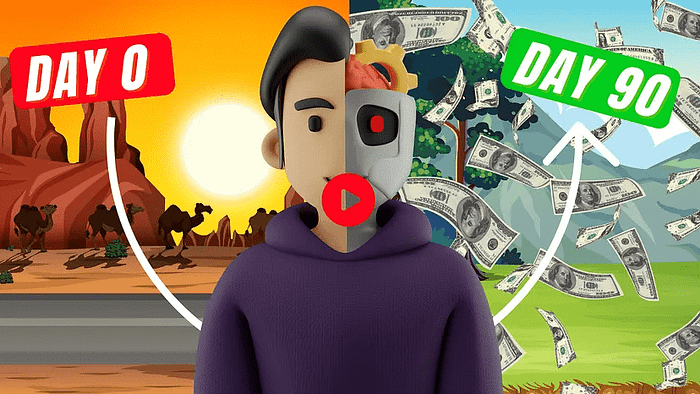In the ever-evolving landscape of marketing and advertising, the art of Copywriting stands as a cornerstone. Whether you’re crafting compelling headlines, persuasive sales pitches, or captivating brand stories, mastering the nuances of Copywriting can propel your business to new heights. As a beginner, navigating the intricacies of this craft can seem daunting, but fear not – we’ve curated a comprehensive guide to help you on your journey to becoming a Copywriting virtuoso.
We strongly recommend that you check out our guide on how to take advantage of AI in today’s passive income economy.
Table of Contents
1. Understand Your Audience
The key to effective Copy-writing lies in understanding your target audience. Before putting pen to paper (or fingers to keyboard), take the time to research and gain insights into their desires, pain points, and motivations. This deep understanding will enable you to craft compelling copy that resonates with your audience on a personal level, fostering a connection that transcends mere words.
2. Craft a Compelling Headline
Your headline is the hook that captures your reader’s attention and entices them to delve deeper into your content. Spend ample time crafting a headline that is attention-grabbing, curiosity-inducing, and promises value. Remember, a lackluster headline can lead to potential readers overlooking your masterpiece, so make it count.
3. Embrace the Power of Storytelling
Humans are hardwired to connect with stories, and Copy-writing is no exception. Weave captivating narratives into your copy, painting vivid pictures that transport your readers on a journey. Whether it’s a relatable customer experience or a brand tale that tugs at the heartstrings, storytelling can elevate your Copy-writing to new heights.
4. Evoke Emotion
Great Copywriting isn’t just about conveying information; it’s about evoking emotion. Tap into the emotional core of your audience by incorporating powerful language that stirs feelings of excitement, curiosity, or even a sense of urgency. When your copy elicits an emotional response, it becomes far more memorable and impactful.
5. Keep It Simple and Clear
While it’s tempting to showcase your vast vocabulary, effective Copy-writing thrives on simplicity and clarity. Use language that is easy to understand, avoiding jargon or convoluted phrasing that can alienate your audience. Remember, your goal is to communicate your message clearly and concisely, not to obfuscate it with unnecessary complexity.
6. Inject Personality and Authenticity
In a world saturated with marketing messages, authenticity is key to standing out. Infuse your Copy-writing with personality and a genuine voice that reflects your brand’s values and resonates with your audience. Avoid generic, robotic language and embrace a conversational tone that fosters a genuine connection.
7. Employ Persuasive Techniques
Copy-writing is an art of persuasion, and mastering persuasive techniques can make all the difference. Leverage techniques like social proof, scarcity, and urgency to nudge your audience towards the desired action. However, exercise restraint and avoid being overly aggressive or manipulative, as this can backfire and damage your brand’s credibility.
8. Optimize for Readability
In the digital age, attention spans are shorter than ever, making readability a crucial factor in effective Copy-writing. Break your content into digestible chunks with clear subheadings, bulleted lists, and short paragraphs. This not only enhances the reading experience but also makes it easier for your audience to grasp your message quickly.
Subtitle 1: Unleash the Power of Persuasion: Mastering the Art of Copywriting
9. Harness the Power of Benefits
When it comes to persuasive Copywriting, focusing on benefits rather than features is key. Instead of listing product specifications, highlight how your offering can solve your audience’s problems, alleviate their pain points, or enhance their lives. Crafting benefit-driven copy can compel your readers to take action.
10. Master the Art of Persuasive Language
Strategic word choice can significantly impact the persuasive power of your Copywriting. Incorporate power words that evoke specific emotions or actions, such as “discover,” “unlock,” or “experience.” Additionally, leverage sensory language to create vivid imagery and make your copy more immersive and memorable.
11. Embrace Calls-to-Action (CTAs)
A well-crafted call-to-action (CTA) is the catalyst that encourages your audience to take the desired action, whether it’s making a purchase, subscribing to a newsletter, or requesting more information. Make your CTAs clear, concise, and compelling, leaving no ambiguity about the next steps.
12. Test and Optimize
Effective Copywriting is an iterative process, and testing is crucial to optimizing your results. Experiment with different headlines, CTAs, and messaging approaches, and analyze the data to determine what resonates best with your audience. Continuously refine and improve your Copywriting based on these insights.
Subtitle 2: From Novice to Pro: Your Roadmap to Copywriting Success
13. Study Successful Examples
Learning from the masters is an invaluable step in your Copywriting journey. Study successful marketing campaigns, website copy, and advertisements from industry leaders. Analyze what makes their Copywriting compelling, and identify techniques and strategies you can incorporate into your own work.
14. Practice, Practice, Practice
Like any skill, Copywriting requires consistent practice to hone your craft. Seize every opportunity to write, whether it’s crafting social media captions, blog posts, or even personal journal entries. The more you write, the more comfortable and confident you’ll become with your Copywriting abilities.
15. Continuously Learn and Evolve
The world of marketing and advertising is ever-changing, and effective Copywriting requires staying ahead of the curve. Commit to continuous learning by reading industry blogs, attending workshops or webinars, and staying updated on the latest trends and best practices. Embrace a growth mindset, and never stop refining your Copywriting skills.
Conclusion
Mastering the art of Copywriting is a journey that requires dedication, creativity, and a willingness to learn. By implementing these 15 best tips, you’ll be well on your way to crafting compelling copy that captivates your audience and drives results for your business. Remember, effective Copy-writing is not just about stringing words together; it’s about forging an emotional connection, telling a story, and persuading your audience to take action. Embrace the power of words, and let your Copywriting skills shine.
FAQ:
What exactly does a copywriter do?
A copywriter is a professional who crafts compelling, persuasive, and engaging written content for various marketing and advertising purposes. They create copy for websites, advertisements, product descriptions, email campaigns, social media posts, and more. The primary goal of a copywriter is to inform, persuade, and motivate the target audience to take a specific action, such as making a purchase, subscribing to a service, or engaging with a brand.
Copywriters collaborate with marketing teams, designers, and other professionals to develop effective messaging strategies that align with the brand’s voice and objectives. They conduct research to understand the target audience, market trends, and competitors to create copy that resonates with readers and drives results.
How can I start copywriting?
To start your copywriting journey, consider the following steps:
- Develop your writing skills: Start by honing your writing abilities. Practice writing in various styles and formats, such as blog posts, social media captions, and product descriptions.
- Study successful examples: Analyze successful copywriting examples from industry leaders. Identify what makes their copy effective and try to incorporate those techniques into your own writing.
- Learn the fundamentals: Familiarize yourself with copywriting principles, such as understanding your target audience, crafting compelling headlines, and using persuasive language.
- Build a portfolio: Create a portfolio showcasing your best writing samples. You can start by writing for your own blog, offering your services to friends or local businesses, or participating in writing challenges.
- Network and seek opportunities: Connect with other copywriters, join online communities, and attend industry events. Look for freelance opportunities or entry-level copywriting positions to gain experience and build your professional network.
How do beginners learn copywriting?
As a beginner, there are several ways to learn copywriting:
- Online courses and tutorials: Enroll in online copywriting courses or watch tutorials on platforms like Udemy, Coursera, or Skillshare. These resources provide structured learning materials and practical exercises to help you master the basics.
- Books and blogs: Read copywriting books written by industry experts to gain insights and learn proven techniques. Follow blogs and publications that focus on copywriting and marketing to stay updated on the latest trends and best practices.
- Practice and feedback: Consistently practice writing copy and seek feedback from experienced copywriters or mentors. Join writing communities or workshops where you can share your work and receive constructive criticism.
- Study successful campaigns: Analyze successful copywriting campaigns across various industries. Deconstruct the copy to identify the strategies and techniques used to engage and persuade the audience.
- Experiment and refine: Don’t be afraid to experiment with different copywriting styles and techniques. Continuously refine your skills based on the results and feedback you receive.
How do I start copywriting with no experience?
Starting a copywriting career with no experience can be challenging, but it’s not impossible. Here are some steps you can take:
- Educate yourself: Invest time in learning the fundamentals of copywriting through online courses, books, and resources. Gain a solid understanding of the principles and best practices.
- Create a portfolio: Build a portfolio of writing samples, even if they are not for actual clients. Write copy for fictitious products, services, or brands to showcase your skills and creativity.
- Offer your services for free: Reach out to local businesses, non-profits, or startups and offer your copywriting services for free or at a discounted rate. This helps you gain practical experience and build a portfolio of real-world projects.
- Leverage your network: Inform your personal and professional network that you’re pursuing copywriting. They may know someone who needs copywriting services or provide referrals.
- Apply for entry-level positions: Look for entry-level copywriting jobs or internships in marketing agencies, content creation firms, or in-house marketing departments. These opportunities provide valuable experience and help you build your professional network.
- Freelance platforms: Explore freelance platforms like Upwork, Fiverr, or Freelancer to find copywriting gigs. Start with smaller projects to build your reputation and gradually take on more complex and higher-paying assignments.
Remember, building a successful copywriting career takes time, dedication, and continuous learning. Stay persistent, refine your skills, and seize opportunities to grow as a copywriter.

We strongly recommend that you check out our guide on how to take advantage of AI in today’s passive income economy.




